Behavior of the Dry Bed Joint in the Mortarless Interlocking Masonry System: an Overview- Juniper Publishers
Juniper Publishers- journal of Civil Engineering
Abstract
Interlocking mortarless masonry has numerous benefits
over the conventional masonry due to its ease of construction and
higher compressive strength by virtue of absence of mortar joints. Dry
contacting surfaces between the blocks play a major role on the
performance of dry stack masonry. In this paper, Dry joint surface
characteristics and close-up deformation properties of interlocking dry
stack blocks and bricks were reviewed as well as the dry joint opening.
It was observed that the contact area increases with increasing of the
compressive load. It's concluded that the behavior of the interlocking
mortaless system is extremely affected by the behavior of the contact
surface and the dry joint under compressive loading. Therefore, further
research related to dry surfaces contact and interface closure and
opening characteristics under compressive loads is needed.
Keywords: Interlocking; Masonry; Dry joint; Mortarless; Contact behavior
Abbreviations: MBTSS: Matrix Based Tactile Surface Sensors; DIC: Digital Image Correlation; ISEB: Interlocking Stabilized Earth Block
Introduction
In the past few decades, the concept of interlocking
mortarless masonry unit has been widely increased in the field of civil
engineering applications and construction practices due to its field
productivity, efficiency and less skilled workers needed in the
production and implementation [1].
One simple thing that absolutely contrasts interlocking bricks from
conventional bricks is the mortar between bricks layers where mortar is
not required for the construction of interlocking bricks. Due to that
characteristic, the construction of masonry walls is faster and needs
even unskilled workers as the bricks are arranged dry and interlock each
other by the protrusions [2].
An assortment of interlocking bricks have been manufactured and
produced during the last few years, varying in the composition of
material, shape, size, strengths required, and usage needed, including
Sparlock, Meccano, Sparfil, Haener, and Hydraform block system [3].
Due to the absence of mortar and the filling material
between the masonry brick joints, the contact area need to be study
with particular attention. The understanding of the compressive behavior
of dry joints is a vital design parameter, for this reason only dry
joint compressibility should be examined. Moreover, dry contacting
surfaces between the blocks and bricks play a major role on the
performance of dry stack masonry [4].
Thus, dry interfaces characterize the behavior of dry stack masonry
under different loads. When the dry stack masonry is subjected to
compression the interfaces gradually close and the surface contact area
increases with the increment in loading [5,6].
However, very limited research outcomes are reported in the literature
on the characterization of the dry interfaces under key loading
conditions. In this paper, a review on the behavior of the contact area
between interlocking bricks or blocks layers is presented.
Dry Joint Closure
Previous studies tests have been conducted to
determine the behavior of contact area between brick layers and its
effects on the overall behavior of masonry systems.
Greve et al. [7]
have used matrix based tactile surface sensors (MBTSS) to determine the
contact pressure and contact area of the dry stack joint subjected
gradually to compression load normal to the dry interfaces. As MBTSS is
an expensive, a cheaper carbon paper insert technique was also utilized
to check its ability to trace surface contact area between the bricks
subjected to compressive loading incrementally. The imprints obtained
from the carbon paper were analyzed using Image J software that
determined the contact area. The comparison between the two techniques
revealed that the carbon paper imprints significantly and consistently
under-predicted the contact area. From the MBTSS data, it was concluded
that the contact pressure and contact area increased gradually under the
increase in loading. It was also observed that some high-pressure
points existed within the contact surface and the location of the point
remained unaffected throughout the loading history which demonstrated
that the unevenness of the surface did not even out even at loads very
close to the ultimate.
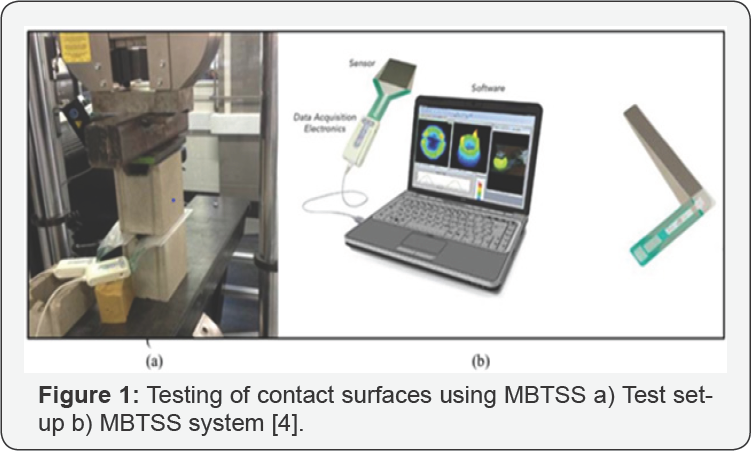
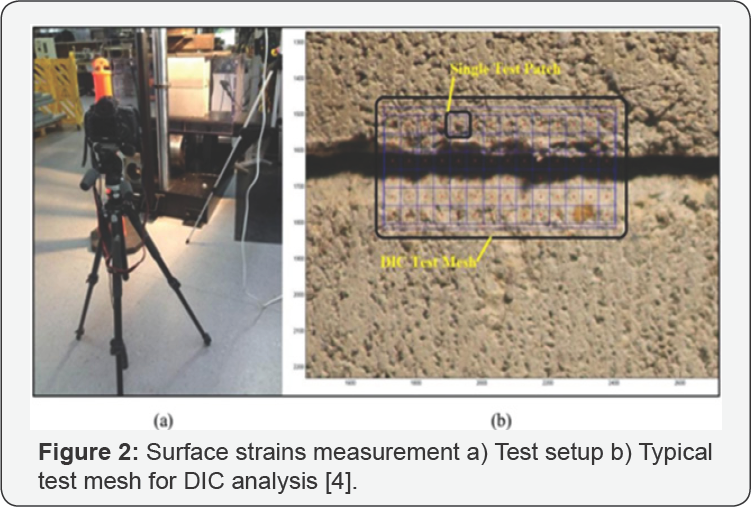
Zahra et al. [4]
have experimentally examined the characteristics of the dry contacting
surfaces of the concrete blocks and bricks. The contact surface area
between two blocks under progressive compression load is determined by
utilizing a matrix based tactile surface sensor positioned between the
contacting surfaces of the two adjacent blocks. The tactile sensor
determined both the contact area and the contact pressure distribution
between the block surfaces as shown in Figure 1.
The contact surface area was found to be progressively increasing from
about a minimum of 15% to a maximum of 95% of the net area with the
progressive increase in compressive load. In addition, the closing
deformation between the two surfaces under the compressive load was
determined by a non-contact digital image correlation (DIC) technique as
shown in Figure 2.
Digital image correlation technique is extensively recognized for
measuring surface strains in numerous laboratory testing including
masonry [8,9].
The close-up joint deformations and strains were measured for
bi-stacked masonry prisms. The test images were analyzed by a special
program innovated by Willam
[9]
to evaluate the strains in the area of the dry joint. It is found that
the seating behavior of the dry interfaces in the early stage of
compression is obvious through the gradually stiffening curve.
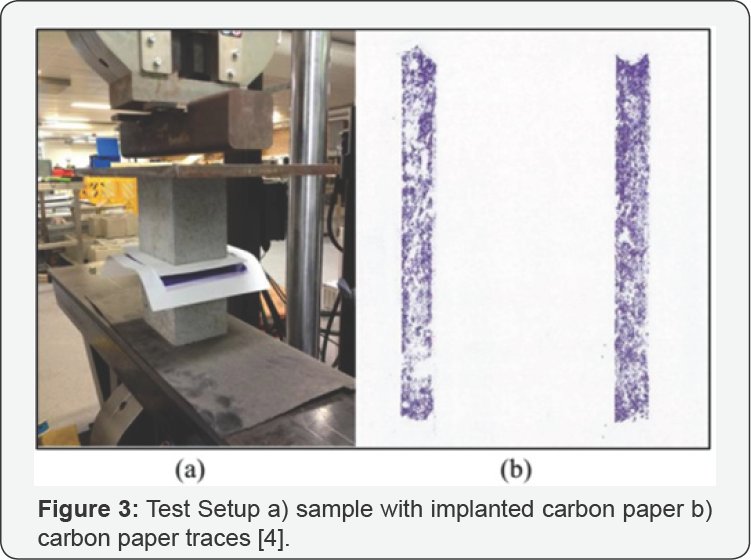
The carbon paper image imprints were traced for loading increments of 20kN from 0kN to100kN as shown in Figure 3.
Each imprint was then analyzed by Image J software to determine the
surface contact area. It can be observed that the contact area increases
with increasing in the applied load. The area is increased from a
minimum value to about 6500mm2 (82%) of the maximum contact area at
100kN for the half blocks,
Marzahn & Konig [6]
have examined the influence of the geometric imperfections in the bed
joints to the structural behavior of mortarless masonry subjected to
compressive loading. Results showed that the surface quality impacted
the strength of brick units where the more irregular the bed planes the
lower the strength because it causes initial deformation. However, the
load bearing capacity was lowered by only 5 to 15% compared to mortared
masonry due to the initial settlement.
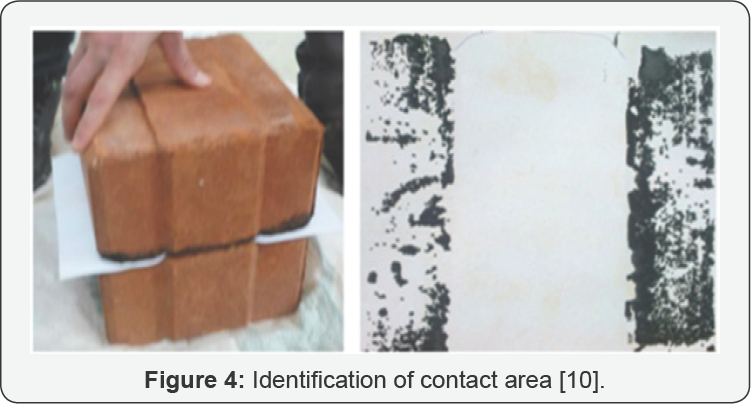
Ayed et al. [10]
have used an image analysis method to determine the behavior of the dry
stacked joint on the interlocking bricks. A plain white paper weighing
80g/m2 and free of physical or chemical effect on block has
been used. The interface of the interlocking blocks was painted and the
white paper between the blocks were placed in order to print the contact
area as shown in Figure 4.
An image analysis was developed on MATLAB in order to estimate the
percentage of the contact surface printed on the paper. It transformed
the image of the printed paper in white and black pixels. Counting of
pixels leads to the percentage of the contact area.
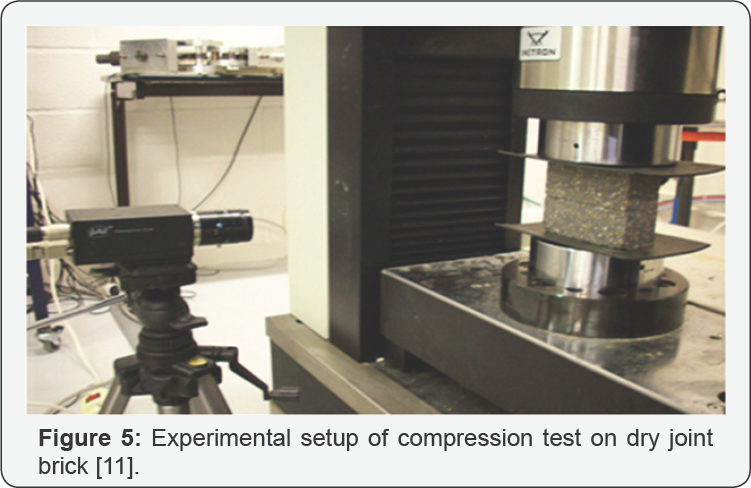
Another recent study conducted by Rekik et al. [11]
used Digital Image Correlation method to examine the compressibility of
dry joints. Compressive tests on specimens that cut from
Magnesia-Carbon mortarless bricks were carried out. Tests were conducted
using a load cell of 200kN as shown in Figure 5
with an accuracy of 0.2% of the attained load and 0.033mm/ min
displacement rate. 2D Digital Image Correlation is utilized to measure
the compressive behavior of the dry joint.
Similarly, Andreev et al. [5]
have investigated the dry joint closure behavior of refractory bricks
under compressive loading. Finally, the procedure of joint closure was
estimated in a roundabout way by stressing specimens with and without
joints in wide temperature extend.
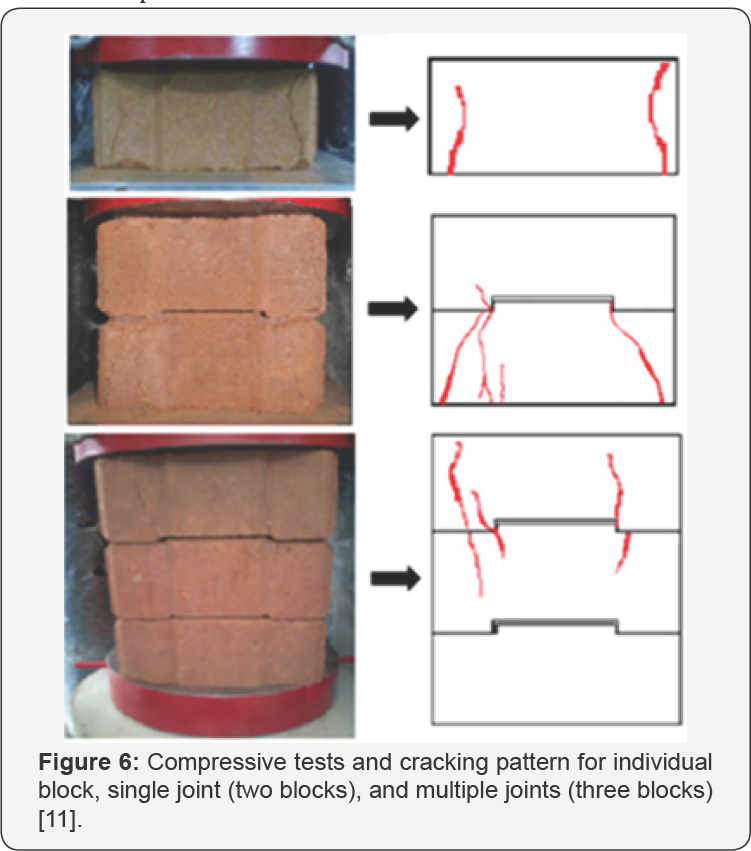
Ayed et al. [10]
have analyzed the effect of contact area and the clearance between the
blocks on the mechanical behavior of interlocking stabilized earth block
(ISEB). The ISEBs were placed dry without grouting and tested under
compression load tests to the mechanical behavior and the contact area
effects, while the effect of the local stress around the clearance were
performed by finite element modeling. The ISEB manufactured by red
earth, sand, and 8 percent of cement. The compressive tests were
conducted on individual block, single joint which consists of two
interlocking blocks, and multiple joints that consists of three
interlocking blocks as shown in Figure 6.
As a result, the compressive strength for individual block, two blocks,
and three blocks were 11.9MPa, 8.2MPa, and 5.5MPa, respectively. That
means the contact area and the clearance between the blocks have an
effect on the masonry compressive strength, causing it to decrease.
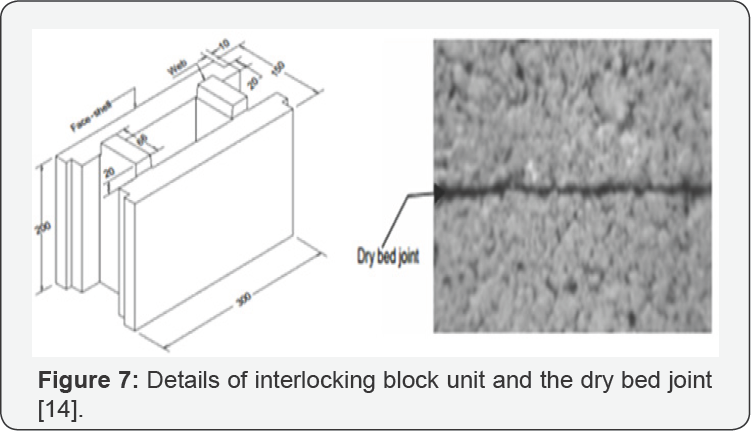
Jaafar et al. have investigated the behavior of the
dry joints of interlocking masonry under compressive loading and
consequently their impacts on the structural behavior of the
interlocking mortarless hollow blocks for grouted and ungrouted prisms
subjected to compression as shown in Figure 7.
Two test setups are experimentally proposed to determine the contact
behavior of dry joints with consideration of the geometric imperfections
in the contacting interfaces. Results revealed that the geometric
imperfections of the brick beds are highly affected the dry joint
behavior and hollow prism deformation. Varied deformation forms are
observed in mortarless un-grouted and grouted prisms. However, this
behavior isn't common in grouted prisms, for the reason that visible
deformation begins after 38% of the maxim loading. Besides, the
differences of strength and deformation in grouted samples are reduced
in compression with those in un-grouted samples.
Dry Joint Opening
Studies stated that opening mechanism of wall
specimens may be explained by arching mechanism in out-of plane wall.
When a wall is subjected to load that is perpendicular direction to wall
face, the wall will deflect in the out-of-plane direction (same
direction where load applied). In mortarless construction, the wall
tends to create an opening between courses where the location of maximum
bending moment occurs. Opening mechanism in dry joint is related to the
arching behavior during out-of-plane loading. Resistance of hollow
masonry walls to out-of-plane loads can be increased by imposing large
in-plane compression forces that can be induced when the wall is rigidly
supported [12].
With increasing loading, flexural opening occurs at mid span. With the
increased load, the wall is hard-pressed against the un-yielded supports
producing clamping forces ( ) at the ends as shown in Figure 8.

Three hinged arches reshaped where the external moment is resisted by the internal couple (p u*ru) where ru is the arch height. The clamping force Pu is a function of dry joint and contact area. The arch height ( ru ) is a function of the wall geometry, contact area (βt/2) and deflection (Δo.β)
is a slope of the bottom course opening, where (t) is the wall
thickness. Therefore, the more the wall deflects, the lower the clamping
force Pu due to the reduction of contact area and thus decreasing of resulting moment.
Studies stated that opening mechanism of wall specimens may be explained bySafiee et al. [13]
have examined the dry joint opening of interlocking mortarless wall
subject to out-of-plane load. During testing, the dry joint opening
mechanism around mid-height of wall, as shown in Figure 9,
was dominated. The opening was measured by Demec points at several
locations along the wall surface. The opening of middle courses of wall
increased as lateral load increased for all series of specimens. The
total opening may be affected by both lateral load and higher
precompressive load. The study exhibited that the opening size was
higher even at lower load. However for the partially grouted walls, the
opening value was relatively limited and mostly occurred at higher
lateral load.
Discussion and Conclusion
Studies stated that opening mechanism of wall
specimens may be explained byDry joint surface characteristics and
close-up deformation properties of interlocking dry stack blocks and
bricks were reviewed in this study as well as the dry joint opening.
It's found that the carbon paper image analysis method is unsuitable to
determine the contact area between the block surfaces accurately.
Meanwhile, the tactile sensors system computes the surface contact area
consistently and reliably. It has been concluded that the contact
surface of the mortar less masonry bricks on initially remained
negligible due to the initial gap and voids between the blocks and
undulations on the dry joint surface. After certain amount of time the
contact area increased with a steep slope until it stabilized. Moreover,
through the image analysis of contact prints, it was shown that the
contacting areas increase with the increasing of the compressive load.
The behavior of the interlocking mortar less system is extremely
affected by the behavior of the contact surface and the dry joint under
compressive loading. The geometric imperfections of the bed interlocking
blocks and bricks were found to be a significant factors impacts the
structural behavior of the mortar less masonry system. Finally, for
increasing the acceptance of dry stack masonry system, further research
related to dry surfaces contact and interface closure and opening
characteristics under compressive loads is needed.
For More Open Access Journals Please Click on: Juniper Publishers
Fore More Articles Please Visit: Civil Engineering Research Journal
Fore More Articles Please Visit: Civil Engineering Research Journal


Comments
Post a Comment